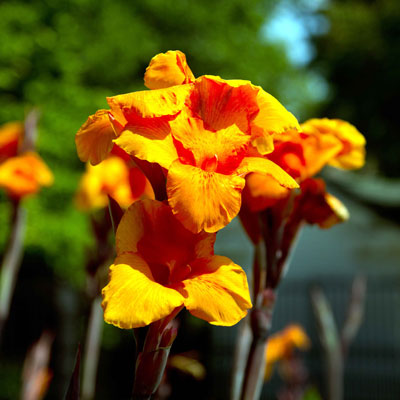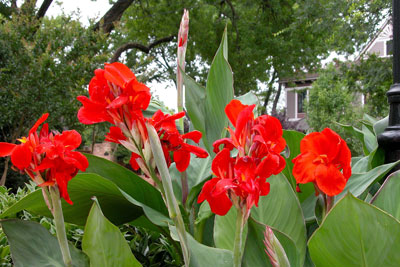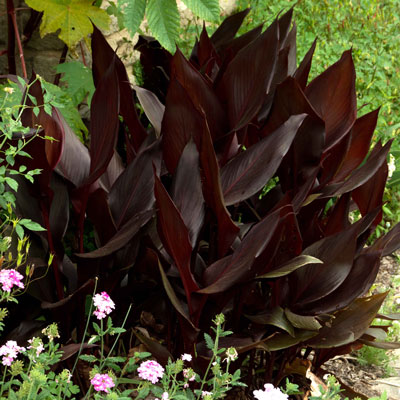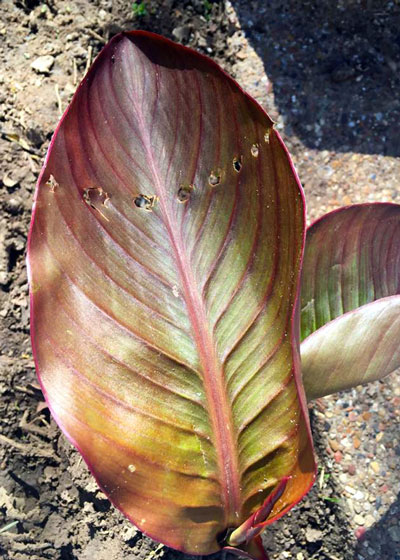Cannas Can Do!

Cannas show up best when used in beds of one variety such as this old orange type.
I grew up with tall, orange cannas across one small side of our backyard in College Station. The neighbors in all directions had them. Everybody seemed to have them. We all passed them around. As we needed space, we made new friends and gave them cannas, too. And people are still doing that to this day.

The Horn family of Carnegie OK has long been known for the quantity, quality and wide variety of their canna roots.
But there are many more varieties of cannas than what you see being passed hand-to-hand, and no one has more than the Horn Canna Farm people in Carnegie, Oklahoma. It’s a small town of less than 2,000 that’s out in the southwest part of the state. The sunrise meets the sunset there with nary a shadow in between, yet to canna lovers, it’s one of the centers of the Universe.
The Horn family used to take a booth at my annual All Texas All Garden Show at the Arlington Convention Center before I sold the show 8 or 9 years ago. Each year they brought a truckload of boxes of plump, vigorous canna roots – dozens of varieties – and by the end of each show they were sold out. I loved visiting with them. Nice people. Great family business of almost 100 years. I thought you might enjoy scrolling through their website.
The Horns are sold out, of course, for 2016, but they’ll be updating the website shortly, and they say some of the old favorite varieties will be coming back. Start making your plans now, while you can see cannas stealing the summer show in your part of the state.
I noticed on the Horn’s retail order form that the annual Carnegie Canna Festival is the last Saturday in September. For more information on that event, call (580) 654-2121. It sounds like fun.
Success With Cannas

When landscapers think of cannas, red is often the color of choice. This is another photo from the Historic District of McKinney.
Here’s what it will take for you to be a prize winner with cannas….
• Full sunlight.
• Well-prepared, highly organic garden soil. Your cannas will be growing in the same spots for a good while, so give them the best.
• Choose varieties that grow to the height you want for that space. There are dwarfs that stay 30 to 36 inches tall, all the way up to types that grow to 6 or 7 feet tall while blooming.

Cannas’ leaves are usually 15 to 18 inches long, making them an ideal plant for a tropical look in the pool area.
• Cannas are very bold-textured, so they’re usually best either grown in clumps or plantings all by themselves, or instead at the backs of your perennial beds.

Even if they never produce any flowers at all, these cannas still make a huge contribution to the gardens of The Antique Rose Emporium in Brenham.
• Keep cannas watered deeply. High-nitrogen fertilizers that have half or more of that nitrogen in slow-release form will keep them growing vigorously. You want that new growth so you can realize maximum flowering.
• Canna leaf rollers cause the leaves to have rows of holes and flowers that fail to open properly. Apply a systemic insecticide to the soil around the plants in mid-May to limit or prevent their damage.

Canna leaf rollers attack foliage while it is still tightly rolled. As the leaves unfurl, the damage becomes obvious.
• Trim off spent flowers by cutting down into the foliage so you won’t see the cut stubs. New flower stems will be produced, keeping the plants colorful spring until fall.
• Cannas’ foliage will die to the ground with the first killing freeze in mid-fall. Give it a couple of days to shrivel and turn brown, then remove it to tidy the beds.
• If you want to dig and divide your cannas, do so either after that first freeze, or perhaps better yet, just before new growth begins (mid-February in South Texas, early March in North Texas).

Some cannas even produce flowers with curious freckling. Just another source of fun with this flower!
